Port Adelaide last wore the famous “prison bars” during its Showdown victory over Adelaide in June. Photo: GETTY IMAGES
Gillon McLachlan did not see it coming, but the AFL chief executive certainly heard about it.
“Who would have thought grown men would care what other men are wearing? But that passion is to be ignored at our peril,” McLachlan said.
Not just grown men, Gillon. Women. Children. A community that the AFL – as McLachlan notes – cannot be ignored. More so when the COVID pandemic has left Australian football to painfully note exactly what peril exists without the fans.
McLachlan’s eye-opening moment – that speaks volumes for that long-held theme of “the love of the jumper” – was in September 2014, when the AFL football department strangely ordered Port Adelaide out of its black jumper while hosting a home elimination final against the black-and-yellow Richmond.
The backlash was heavy – and resolved by allowing Port Adelaide to dust down its black-and-white “prison bars” guernsey first worn in the SANFL in 1902.
And the passion that is unleashed when Port Adelaide fans learn that Collingwood – and not the AFL Commission – has the veto call on this famous jumper is another reminder for McLachlan and the game’s rulers that they should respect (if not fear) upsetting a devoted fan base more than bow to Eddie McGuire.
Port Adelaide wore the bars on June 13 this year at Adelaide Oval for the first time in an AFL Showdown with the Crows – and for just the fifth time in the club’s 542 premiership games since rising from the SANFL to the AFL in 1997.
It will soon present to the AFL Commission and executive a proposal to don the bars in every Showdown from next season. There will be a petition with more than 35,000 attached … as a reminder, as McLachlan puts it, of how “that passion is to be ignored at our peril”.
Not all the signatories are Port Adelaide fans; there also are advocates from other supporter bases expressing their dismay that Port Adelaide cannot wear its own jumper, one that is without comparison to any other – it is without stripes, hoops or a sash.
And then there is McGuire, the Collingwood president vowing to throw down his veto card with a pack of silks in any courtroom that wants to hear a debate on trademarks and copyrights.
Why it comes to this – when there are so many pressing issues in football – is the price the AFL pays for bringing McGuire into the debate.
Remarkably, no other club has played such a heavy hand – or had the same veto rights while the VFL/AFL has expanded.
Did Fitzroy tell Adelaide in 1990 that the Crows would need to go with their original plan of blue, white and green because the Lions had exclusive rights to red, gold and blue? Did Adelaide protest two decades later when Gold Coast presented the same tri-colour ensemble?
The Port Adelaide Football Club – celebrating its 150th anniversary this year – does not want to be “Magpies” as it became in the SANFL. In fact, the club makes more of being known as “Port Adelaide”.
It does not want to wear the Collingwood stripes (as it did for a while in the SANFL, including during patriarch Fos Williams’ first premiership triumph in 1951. The “bars” became a lock later that decade – while Port Adelaide won six in a row from 1954-1959 – on the strong recommendation of Sir Donald Bradman).
It simply wants to respect its heritage in the match that defines South Australian football – the Showdown derby with the non-Port Adelaide crowd that makes up the Crows.
And most importantly, the Port Adelaide Football Club wants to honour the wishes of its fans, who in increasing numbers turn up at home games at Adelaide Oval in the bars jumper – some passed down generation to generation as a family ritual and heirloom.
The debate – and veto power at Collingwood – is now 30-years long. In 1990, when Port Adelaide turned South Australian football upside down by signing a heads of agreement with the AFL to join the national league in 1991, the rival SANFL clubs were charged with lobbying each of the 10 Victorian-based clubs carrying a theme to block voting for Port Adelaide’s entry.
SANFL president Max Basheer, one of the shrewdest men in law and football, won over then Collingwood president Allan McAllister with one question: “Do you want another black-and-white team in your space?”
McAllister’s latter-day equivalent McGuire has kept up the roadblock … and generation after generation of AFL leaders have baulked at settling the issue.
Even when another South Australian – one with a clear understanding of the Port Adelaide story – Wayne Jackson, was in the AFL chief executive chair in the early 2000s, there was a preference to play the long game.
Jackson believed McGuire would have moved on by 2010 after a decade as Collingwood president, and that a new regime would be far less dogmatic on guernsey designs. “What’s a decade to wait in the long picture?” Jackson would say. But a decade has become two.
And the debate swings – in official circles and unofficially among two vocal supporter bases – on well-worn themes.
Collingwood was first in black and white. True, Port Adelaide started in blue and white in 1870 and from 1884-1901 it has worked many variations of magenta and blue. But Collingwood was not first among all teams with black-and-white stripes in Australian football. The South Australian representative team during the colonial era and at the start of federation wore black-and-white stripes from 1881-1906, well before Collingwood was formed in 1892.
Port Adelaide formally adopted black and white – with bars rather than stripes – on March 26, 1902, after the players complained their magenta jumpers faded too quickly. No dye could be found to solve this problem.
Collingwood has a trademark right to exclusive use of black-and-white stripes. Law always is based on interpretation, but the AFL owns the names, jumper designs and trademarks of the 18 national league clubs. Even chocolatier Cadbury’s last year – after 24 years of legal arguments – gave up its campaign to trademark the colour of purple.
Collingwood has a binding written agreement with Port Adelaide that concedes the black-and-white jumper to the Victorian club. No. In 2007, when the AFL threw back to living in the ’70s for heritage round, Port Adelaide had just one guernsey in its nostalgia closet: The black-and-white bars with the 1977 jumper that included the SANFL’s centenary logo on the left breast.
Port Adelaide had to sit out the heritage round in 2006 – devoted to the “Electrifying 80s” – because it had only its black-and-white bars from the 1980s.
To break the impasse, the AFL, Collingwood and Port Adelaide agreed: (a) Port Adelaide could wear any of the historical jumpers in heritage-round matches in Adelaide, but not against Collingwood, and (b) Port Adelaide could wear black-and-white jumpers in heritage-themed rounds in Adelaide, but not against Collingwood.
Heritage rounds ended immediately after Port Adelaide wore the 1977 bars jumper against the Western Bulldogs at the Docklands Stadium in 2007.
Since then, Port Adelaide has worn black-and-white in 2013 against Carlton in the last AFL game played at Football Park; in the 2014 elimination final against Richmond at Adelaide Oval, and this year in Showdown XLVIII.
None of these matches was hit with a Supreme Court injunction from Collingwood – and Collingwood’s commercial and merchandise capacity was not diminished by Port Adelaide appearing in black-and-white jumpers. Instead, a supporter base at Port Adelaide reaffirmed its love for the jumper.
For all this, the battle continues with the AFL putting in place a farce: One club – and only one club – is allowed to dictate what another club can wear.
AFL Commission chairman Richard Goyder and his fellow AFL leaders will need to consider that in 2021 – in (hopefully) a post-COVID era – there will be greater need to honour the desire of a fan base.
PLEASE HELP US CONTINUE TO THRIVE BY BECOMING AN OFFICIAL FOOTYOLOGY PATRON. JUST CLICK THIS LINK.
If McLachlan has forgotten his own warning from 2014, there are enough grand statesmen – particularly outside the Port Adelaide Football Club – who make the case for the black-and-white bars to become a lasting image of the Showdown. Dennis Cometti, who regards the bars as the “best uniform in Australian football”. David Parkin. Mike Sheahan.

Even Collingwood coach Nathan Buckley, a Port Adelaide SANFL premiership player, has endorsed this theme.
“To wear the prison bar strip is a fair acknowledgement of the history of the football club,” said Buckley, who played 37 league games for Port Adelaide before joining Brisbane in 1993 en route to Collingwood.
“And I think that’s something that no-one would have any specific issues with … it’s a fair celebration for Port to be able to do that in a Showdown.”
Indeed, the Showdown – a match that does nothing to Collingwood’s image – is the appropriate place for the Port Adelaide bars jumper. It is the derby that divides South Australia – just as the love for that black-and-white jumper also created hate for that guernsey among non-Port Adelaide supporters in SANFL circles.
Showdowns would be enhanced in their presentation with a derby dedicated jumper from Port Adelaide.
George Fiacchi was Buckley’s teammate in the 1992 SANFL grand final – one of his seven winning grand finals during his 236-game league career from 1985-1997. A Hall of Famer at Port Adelaide, Fiacchi is the spiritual leader of the #bringbackthebars campaign that has captured the passion of thousands of fans.
“The Port Adelaide Football Club needs to make a stand,” says Fiacchi, a long-serving club director (2012-2019).
This will unfold before the AFL when Port Adelaide places its formal submission to turn the bars jumper into its official Showdown uniform.
But Fiacchi tells Footyology the jumper should be worn whenever Port Adelaide sees fit. He concedes it would not be worn against Collingwood, home or away – even though the clubs managed to both appear in black-and-white in an exhibition match at Football Park in 1992. Fiacchi puts the onus on the AFL to correct a wrong.
“We are a traditional, community football club with 150 years of history,” Fiacchi told Footyology. “It’s time the AFL stopped treating the Port Adelaide Football Club like a franchise team.
“Our elevation to the AFL should be viewed just as it was with the traditional clubs in Melbourne. We had to sacrifice more than any other club to enter the AFL; we retired our Magpie emblem; we gave away our recruiting zones that nurtured a multitude of champions to our club; we lost juniors that included under-8s. And we were told to pack away and our famous guernsey, our bars.
“In hindsight we gave away our soul. Our fight to bring back the bars is not about living in the past. We are acknowledging our proud tradition. The Port Adelaide bars link our proud past to our future.
“To suggest one club can exclusively own the colours of black and white is ludicrous. And when you sit the Collingwood jumper and the Port Adelaide guernsey side by side, they are as different as the colours black and white. Any judge would laugh at the suggestion they are similar in design.
“As Port Adelaide fans, we want to see the club’s leaders to take up the fight and not compromise. We should be able to wear the bars when we see fit. It works for Showdowns, special occasions such as Anzac Day and heritage rounds, if they resume.
“It would be disrespectful to wear it against Collingwood as they were part of the AFL competition before Port Adelaide joined in 1997. But the Port Adelaide Football Club gave up its soul to join the AFL. It’s time to take it back. #bringbackthebars.”
McLachlan should be hearing an echo … that passion is to be ignored at our peril.
Michelangelo Rucci is a former Port Adelaide Football Club historian and statistician and currently contributes to the club’s website.

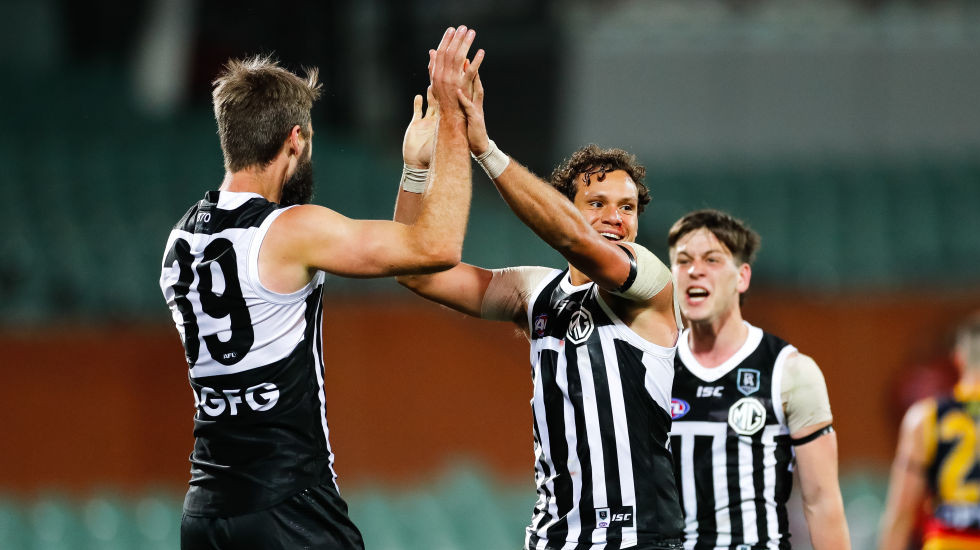


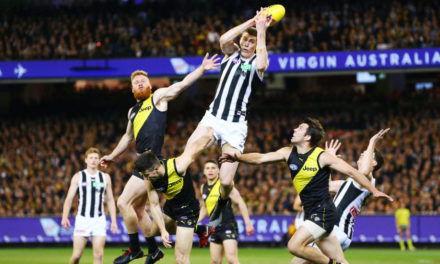
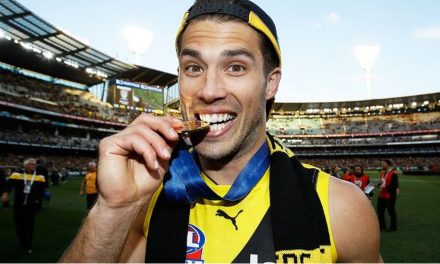
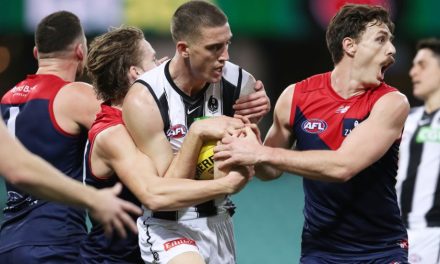
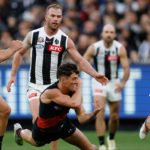



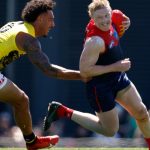

The AFL needs to take control of the whole jumper issue with the AFL Board making the final decision. No single club should be able to dictate what jumper any club should wear. Port Adelaide agreed to not wear the SANFL jumper so they could get into the AFL fullstop.
Collingwood likewise should not be able to tell the AFL what jumper it is going to use as an away jumper. The problem here is the AFL allowing this farce to continue.
Cause it all starts so innocent & small. We wont wear it. We’ll only wear it once for heritage round. We’ll wear in the showdowns, once a year. We’ll wear it for home games. We’ll wear it whenever we see fit.
If you have a snake in the yard, do you let it slither inside? No you cut its head off on the lawn.
Why dont you just make the white stripes Teal? Home jumper black base, teal stripes. Away guernsey could be white base with Teal stripes.
As for fitzroy/adelaide argument, i do remember the disgust from fitzroy fans at the time but the club had no cash. No cash to continue playing let alone fight the AFL and another states team.
Petition of 35,000 saying yes, including fans of other teams. Collingwood could produce 350,000 signatures saying no and probably 500,000 if they asked other teams fans.
Collingwood has worn black n white stripes for 130 yrs, Port wore black n white stripes for 91. Port joined a comp with a pre existing team wearing black n white stripes. You agreed then that that wouldn’t work. Nothings changed.
If the AFL let port get away with this, it will open the floodgates. Any team joining the comp could then effectively highjack any other existing clubs jumper.
Port should be thankful for the various occasions they have worn black n white stripes in the AFL and stop trying to push their luck.
Are you aware of the agreement struck between then collingwood president allan mcalister and then Port Adelaide president Greg Boulton prior to Port Adelaide’s entry into The VFL?
It stipulated that should Port Adelaide finish higher on the VFL ladder than collingwood for three consecutive seasons then collingwood’s objections to Port Adelaide wearing our Black And White Guernsey and even our Magpie emblem would be waived.
We finished higher on the VFL ladder than collingwood in our first FIVE consecutive seasons.